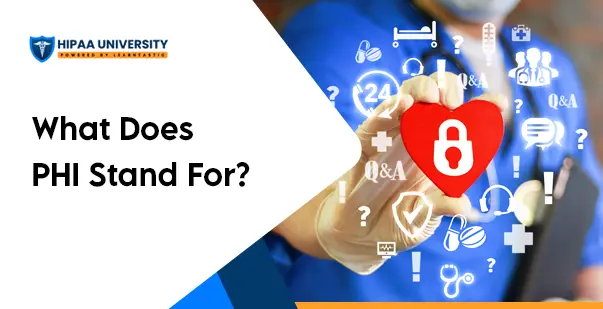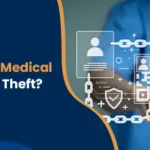What Does PHI Stand For?

August 7, 2024
Today, personal health information plays a major role in how care is delivered. Doctors and nurses rely on this data to make decisions, and patients trust that it stays private. But as more records are stored digitally, protecting that information has become more important than ever.
Healthcare providers must not only give the best care, but also keep patient details safe. That’s where PHI comes in. Knowing what it is, how it’s used, and what rules apply can help your organization stay compliant and avoid serious penalties.
What Does PHI Stand For?
PHI stands for Protected Health Information. It includes any part of a medical record that could be used to identify someone—like a name, date of birth, or diagnosis. This information is often shared or used during treatment, billing, or other healthcare services.
Between 2009 and 2020, more than 176 million people in the U.S. were affected by PHI breaches. That’s a clear reminder of how important it is to protect this kind of data.
What Is PHI?
PHI includes any personal health information that can be linked to an individual. That means things like medical records, appointment notes, or even conversations between doctors and nurses.
HIPAA and the HITECH Act (Health Information Technology for Economic and Clinical Health) set the rules for how this data must be handled. Any app or tool that stores, collects, or shares PHI needs to follow HIPAA compliance guidelines.
Key Components of PHI: The Direct Identifiers
Under HIPAA, there are specific identifiers that, when tied to health data, make it PHI. These include:
- Full names
- Addresses
- Dates related to treatment or identity
- Phone and fax numbers
- Email addresses
- Social Security Numbers
- Medical record numbers
- Health insurance details
- License or certificate numbers
- Vehicle identifiers
- Device serial numbers
- IP addresses or URLs
- Biometrics like fingerprints or voiceprints
- Facial images
- Genetic information
If a healthcare provider or insurer collects or stores any of these alongside health data, it’s considered PHI—and must be protected.
Why HIPAA Matters for PHI
HIPAA is the U.S. law that sets rules for keeping PHI private and secure. It applies to healthcare providers, insurers, clearinghouses, and even third-party vendors who work with PHI.
Covered entities and business associates must follow privacy and security rules that limit how PHI can be used or shared. Unless a patient gives permission or there’s a legal requirement, PHI can only be used for treatment, payment, or healthcare operations.
HIPAA also requires safeguards like:
- Firewalls
- Antivirus software
- Intrusion detection systems
- Regular data backups
These help protect PHI from breaches or misuse.
Why Does PHI Matter?
Protected Health Information (PHI) plays a critical role in healthcare, not just for patients and providers, but also for researchers when it’s de-identified. Here’s why PHI is so important:
- It’s valuable to cybercriminals. PHI contains personally identifiable information (PII) that can be exploited for identity theft, sold on the dark web, or used in ransomware attacks.
- Patient privacy is a legal and ethical responsibility. Healthcare providers are legally required to keep patient records confidential. This responsibility makes PHI protection a top priority.
- Most PHI is deeply personal. From medical diagnoses to insurance details, healthcare organizations must take strong steps to secure this sensitive data at all times.
- It builds trust. Patients count on healthcare professionals and organizations—like doctors, hospitals, and health plans—to protect their privacy. That trust is essential to the provider-patient relationship.
- PHI protection follows the patient. Whether care is delivered in-person, virtually, or remotely, PHI must remain secure across every setting.
- Patients have rights. Under HIPAA, individuals can request updates or corrections to their PHI held by covered entities, reinforcing transparency and accountability.
🔗 Read More: What is considered PHI under HIPAA?
Who Uses PHI?
Protected Health Information (PHI) touches nearly every corner of the healthcare system. Anyone involved in patient care, billing, or insurance is likely handling PHI in some way—and that means they’re also responsible for protecting it.
Healthcare Providers
Doctors, nurses, physician assistants, and even nursing aides regularly view or update medical records. Whether they’re checking test results or discussing treatment plans, they’re expected to keep patient information private. Knowing what PHI is and how to handle it properly is part of the job.
Health Insurance Companies
Insurance companies are considered covered entities under HIPAA. They use PHI to process claims, confirm benefits, and answer coverage questions. But with that access comes the need to be cautious—only the necessary information should be shared, and it has to be done securely.
Government Health Programs
Medicare and Medicaid, as well as programs that support veterans and active-duty military, also work with PHI. These government-backed services fall under HIPAA and are held to the same standards when it comes to keeping patient data safe.
Clearinghouses
Clearinghouses play a behind-the-scenes role. They help make sure that data—especially billing information—is formatted correctly so it can move smoothly between healthcare providers and insurance companies. Even though they’re not always visible to patients, they still handle PHI and must follow HIPAA rules just like everyone else.
What Is Not Considered PHI?
While a lot of information in healthcare is sensitive, not everything stored in a medical office counts as Protected Health Information (PHI). It’s important to know the difference.
Here are a few examples of what is not considered PHI:
- Education records
- Employee files
- Pay stubs
- General accounting documents
These types of records may be stored within a healthcare setting, but unless they’re tied to a specific patient’s medical care, they don’t fall under HIPAA’s definition of PHI.
Still, when in doubt, it’s smart to treat information cautiously. If you’re unsure whether something qualifies as PHI, it’s always a good idea to double-check or ask a supervisor. That extra step can help prevent mistakes and keep confidential information secure.
PHI and Its Various Forms
Protected Health Information (PHI) can take many forms. It includes things like medical histories, lab results, insurance details, and electronic health records.
Electronic PHI (ePHI): This refers to PHI that’s created, stored, shared, or received in a digital format—like through electronic health record (EHR) systems or secure email.
Paper-Based PHI: PHI also shows up in printed materials, including medical bills, insurance documents, doctor’s notes, and other forms commonly used by healthcare professionals.
HIPAA requires organizations to treat both electronic and paper records with the same level of care—but there are important differences, like how quickly a patient can request access or how records should be properly disposed of. Identifiers play a key role in deciding whether information counts as PHI, making it essential to manage and protect these records correctly.
🔗 Read More: Who Must Comply with HIPAA Rules and Regulations?
Best Practices for Managing PHI
Here’s how healthcare teams can keep PHI safe and stay HIPAA compliant:
- Know what counts as PHI: If it can identify a patient and relates to their health, treat it as PHI.
- Use strong passwords: Secure systems that store or access PHI. Update them regularly.
- Encrypt your data: Turn PHI into unreadable code unless the right key is used.
- Limit access: Only authorized staff should see or use PHI.
- Train your team: Everyone should understand the basics of HIPAA and PHI protection.
- Update your systems: Keep software up to date to protect against cyber threats.
- Have a response plan: Know what to do if PHI is lost or stolen.
- Use secure channels: Don’t share PHI through unsecured email or messaging.
- Conduct audits: Regularly review how your team handles PHI.
- Stay informed: Keep up with changes to HIPAA and healthcare privacy laws.
Final Thoughts
Knowing what PHI stands for—and how to handle it properly—is essential in today’s healthcare world. It’s not just about avoiding fines or breaches; it’s about protecting your patients and building lasting trust.
By staying informed, following best practices, and keeping your systems secure, your organization can confidently manage PHI while staying compliant with HIPAA regulations.





